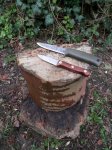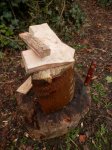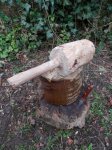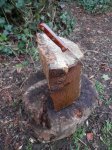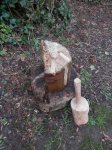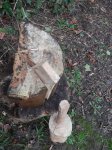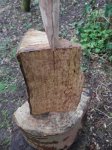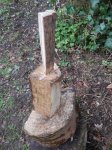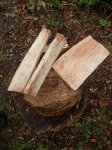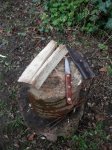Whilst writing an upcoming article for the website, I was reminded of a recent thread from a chap who managed to bend his knife by driving it through a log. I figured I would just throw up this little post to offer an alternative if you don't have a crowbar-bushcraft knife or axe.
I refuse to use the word 'batoning' to describe this practice. Batoning, is derived from the French 'baton' or 'stick', so as English speakers we could equally use the English word 'bludgeon' to describe the practice of driving a poor defenceless knife through a log, despite often having an axe (a tool literally designed for splitting wood) to hand. I don't remember this technique being common practice in outdoor pursuits before the modern bushcraft era (ie Ray Mears et al), but that could be rose tinted memories? There are (very) rare occasions, I grant you, that even I find that I have to split a piece of wood without an appropriate tool. I have in the past (as a child) even done this with a Swiss army knife, without breaking it.
The key is the power of the wedge. On a larger scale this method can be used to split whole trees or even rocks. In this case I grabbed a couple of seasoned sticks from my kindling pile, but even a green twig can be used quite happily and so requires no forethought and very little preparation. Simply make a small wedge (or two, or three depending on the size log). Your knife is designed for cutting and carving, not splitting; so use it to carve a wedge on a stick! This is literally 30 seconds work and will save your knife any potential damage, save potential strain to you hand/wrist and allows you to split larger pieces of wood than your knife might.
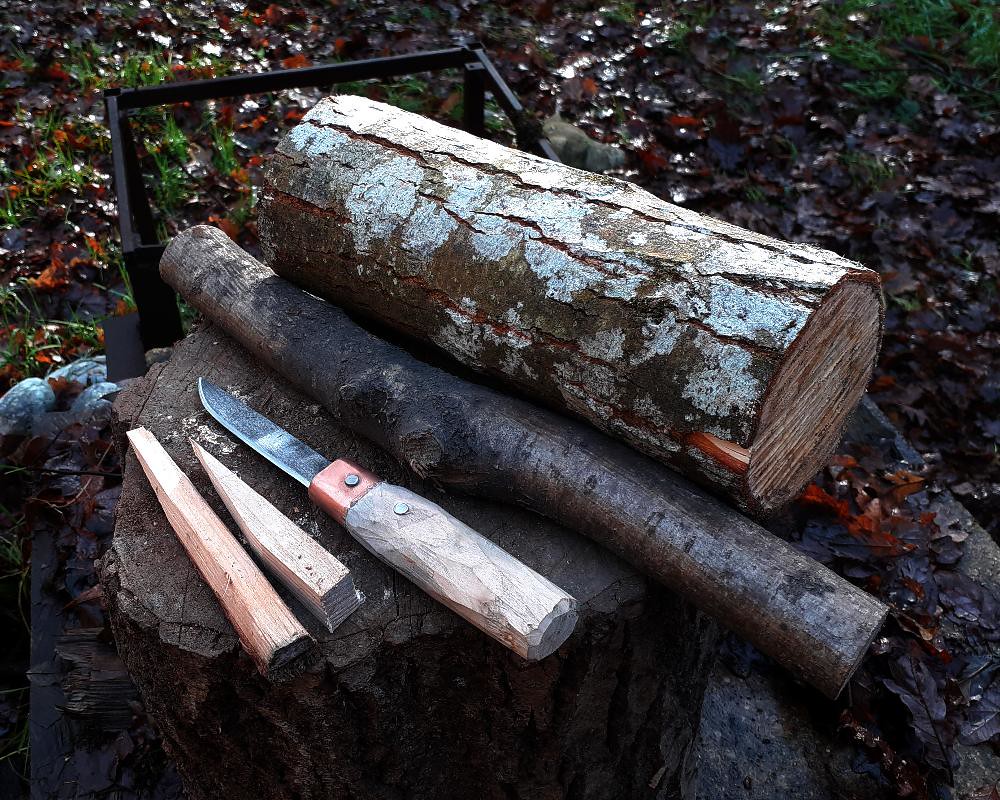 splitting a log1 by buddknives, on Flickr
splitting a log1 by buddknives, on Flickr
Place the knife on the end of the log to be split, holding the handle loosely (gripping the handle tight can lead to damage or pain) and drive it in using a wooden mallet or stick (your actual baton!). Once you have sticked, sorry 'batoned' (roll eyes), the knife in as far as it goes, drive a wedge in behind it (rather than levering the handle, striking the tip or otherwise risking your knife). In this case, the log was not much wider than the blade length, but this method works with any diameter log.
 splitting a log 2 by buddknives, on Flickr
splitting a log 2 by buddknives, on Flickr
The first wedge is driven in next to the handle where I know the log to be split in the correct place. As soon as it is tight and beginning the split, the second wedge is put in at the other end of the blade. The two wedges are driven a little deeper, opening the crack wider than the blade thickness and I can take my knife away to safety. A few more strikes on alternating wedges and the log is cleaved in two.
 splitting a log 3 by buddknives, on Flickr
splitting a log 3 by buddknives, on Flickr
The knife used in this picture was made from a saw blade, so is less than 1mm thick. I could very well use this knife to cleave an entire tree without damaging it, just by making a few wedges with it first!
I refuse to use the word 'batoning' to describe this practice. Batoning, is derived from the French 'baton' or 'stick', so as English speakers we could equally use the English word 'bludgeon' to describe the practice of driving a poor defenceless knife through a log, despite often having an axe (a tool literally designed for splitting wood) to hand. I don't remember this technique being common practice in outdoor pursuits before the modern bushcraft era (ie Ray Mears et al), but that could be rose tinted memories? There are (very) rare occasions, I grant you, that even I find that I have to split a piece of wood without an appropriate tool. I have in the past (as a child) even done this with a Swiss army knife, without breaking it.
The key is the power of the wedge. On a larger scale this method can be used to split whole trees or even rocks. In this case I grabbed a couple of seasoned sticks from my kindling pile, but even a green twig can be used quite happily and so requires no forethought and very little preparation. Simply make a small wedge (or two, or three depending on the size log). Your knife is designed for cutting and carving, not splitting; so use it to carve a wedge on a stick! This is literally 30 seconds work and will save your knife any potential damage, save potential strain to you hand/wrist and allows you to split larger pieces of wood than your knife might.
 splitting a log1 by buddknives, on Flickr
splitting a log1 by buddknives, on FlickrPlace the knife on the end of the log to be split, holding the handle loosely (gripping the handle tight can lead to damage or pain) and drive it in using a wooden mallet or stick (your actual baton!). Once you have sticked, sorry 'batoned' (roll eyes), the knife in as far as it goes, drive a wedge in behind it (rather than levering the handle, striking the tip or otherwise risking your knife). In this case, the log was not much wider than the blade length, but this method works with any diameter log.
 splitting a log 2 by buddknives, on Flickr
splitting a log 2 by buddknives, on FlickrThe first wedge is driven in next to the handle where I know the log to be split in the correct place. As soon as it is tight and beginning the split, the second wedge is put in at the other end of the blade. The two wedges are driven a little deeper, opening the crack wider than the blade thickness and I can take my knife away to safety. A few more strikes on alternating wedges and the log is cleaved in two.
 splitting a log 3 by buddknives, on Flickr
splitting a log 3 by buddknives, on FlickrThe knife used in this picture was made from a saw blade, so is less than 1mm thick. I could very well use this knife to cleave an entire tree without damaging it, just by making a few wedges with it first!

